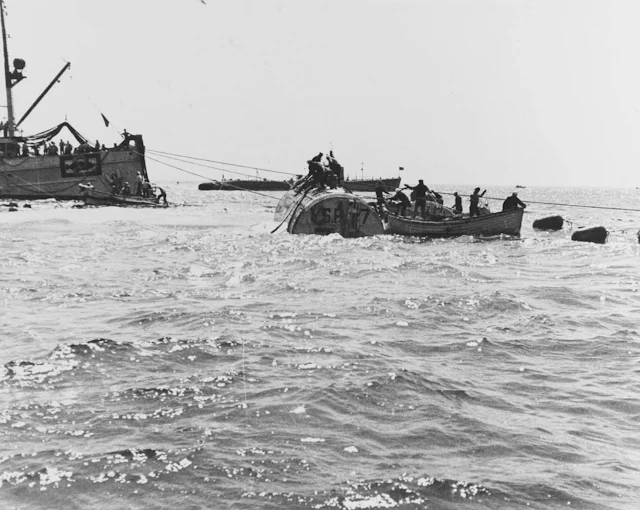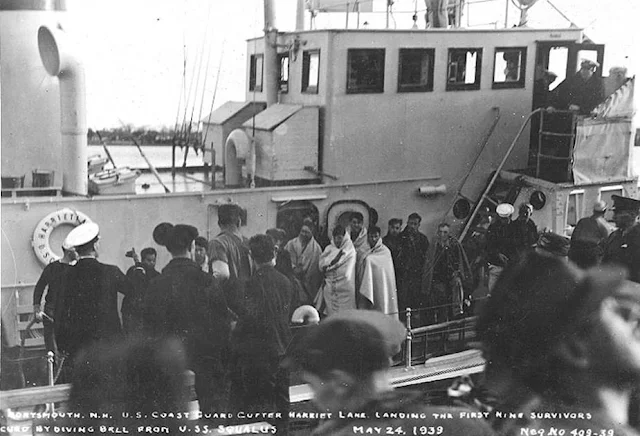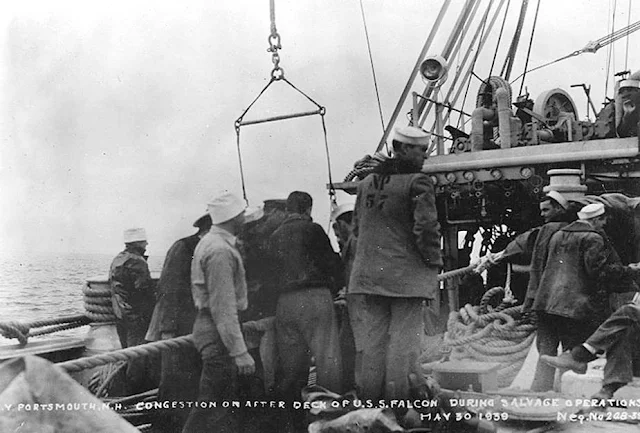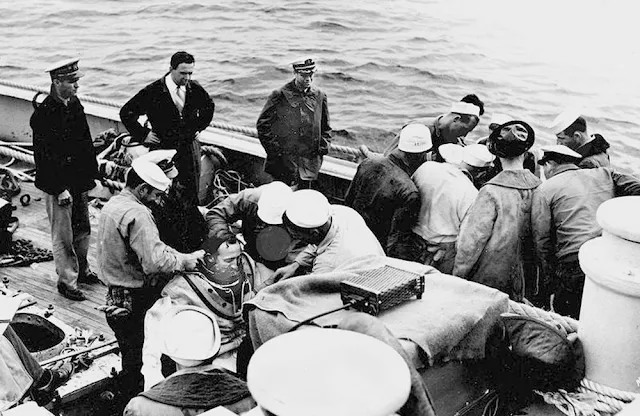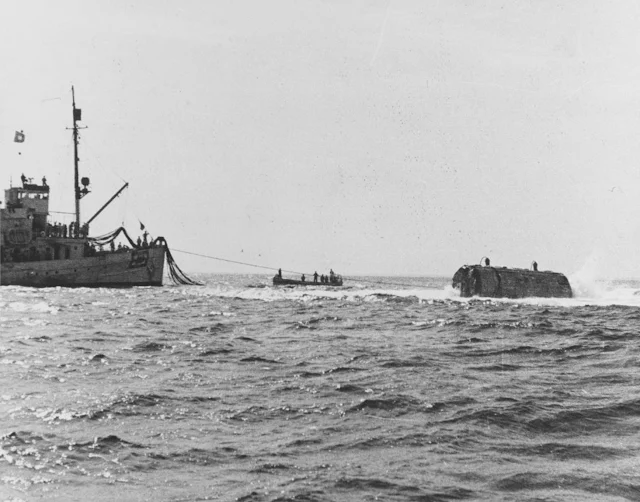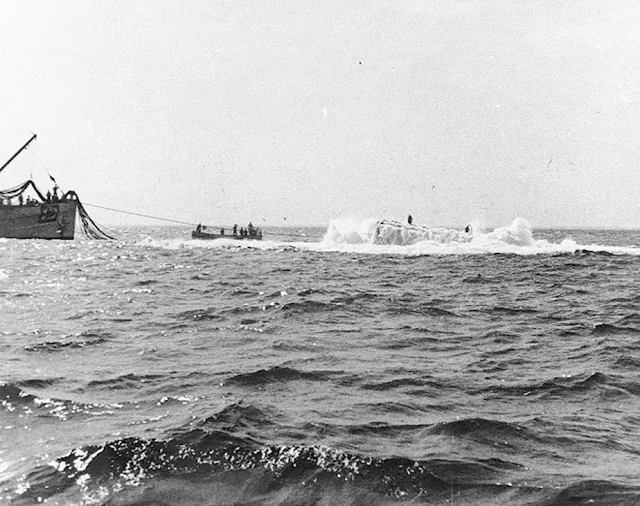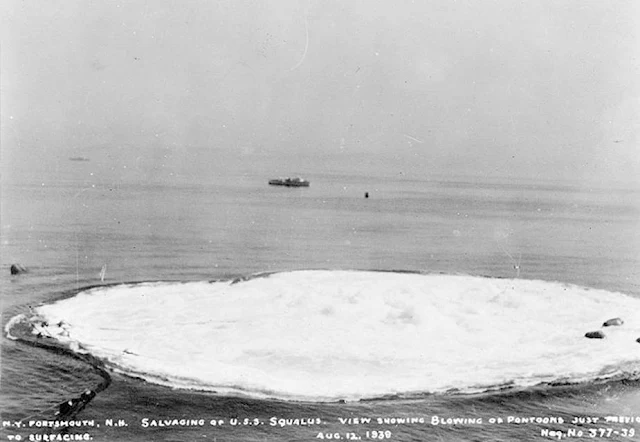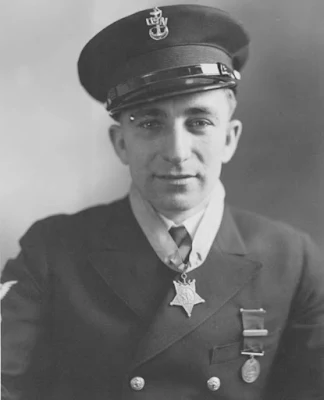 |
| USS Sailfish (SS-192) off the Mare Island Navy Yard, 13 April 1943. (Naval History and Heritage Command 19-N-43269) |
USS Sailfish (SS-192), was a US Sargo-class submarine, originally named Squalus, known for her tour of duty in the Pacific War during World War II.
Her keel was laid on 18 October 1937 by the Portsmouth Naval Shipyard in Kittery, Maine, as Squalus, the only ship of the United States Navy named for the squalus. She was launched on 14 September 1938 sponsored by Mrs. Thomas C. Hart (wife of the Admiral), and commissioned on 1 March 1939, with Lieutenant Oliver F. Naquin in command. Due to mechanical failure, Squalus sank during a test dive on 23 May 1939. She was raised, renamed, and recommissioned on 15 May 1940 as Sailfish.
On 12 May 1939, following a yard overhaul, Squalus began a series of test dives off Portsmouth, New Hampshire. After successfully completing 18 dives, she went down again off the Isles of Shoals on the morning of 23 May at 42°53′N 70°37′W. Failure of the main induction valve caused the flooding of the aft torpedo room, both engine rooms, and the crew's quarters, drowning 26 men immediately. Quick action by the crew prevented the other compartments from flooding. Squalus bottomed in 243 ft (74 m) of water.
Squalus was initially located by her sister ship, Sculpin. The two submarines were able to communicate using a telephone marker buoy until the cable parted. Divers from the submarine rescue ship Falcon began rescue operations under the direction of the salvage and rescue expert Lieutenant Commander Charles B. "Swede" Momsen, using the new McCann Rescue Chamber. The Senior Medical Officer for the operations was Dr. Charles Wesley Shilling. Overseen by researcher Albert R. Behnke, the divers used recently developed heliox diving schedules and successfully avoided the cognitive impairment symptoms associated with such deep dives, thereby confirming Behnke's theory of nitrogen narcosis. The divers were able to rescue all 33 surviving crew members from the sunken submarine. Four enlisted divers, Chief Machinist's Mate William Badders, Chief Boatswain's Mate Orson L. Crandall, Chief Metalsmith James H. McDonald and Chief Torpedoman John Mihalowski, were awarded the Medal of Honor for their work during the rescue and subsequent salvage. (The successful rescue of Squalus survivors is in marked contrast to the loss of Thetis in Liverpool Bay just a week later.)
The navy authorities felt it important to raise her as she incorporated a succession of new design features. With a thorough investigation of why she sank, more confidence could be placed in the new construction, or alteration of existing designs could be undertaken when cheapest and most efficient to do so. Furthermore, given similar previous accidents in Sturgeon and Snapper (indeed, in S-5, as far back as 1920), it was necessary to determine a cause.
The salvage of Squalus was commanded by Rear Admiral Cyrus W. Cole, Commander of the Portsmouth Naval Shipyard, who supervised salvage officer Lieutenant Floyd A. Tusler from the Construction Corps. Tusler's plan was to lift the submarine in three stages to prevent it from rising too quickly, out of control, with one end up, in which case there would be a high likelihood of it sinking again. For 50 days, divers worked to pass cables underneath the submarine and attach pontoons for buoyancy. On 13 July 1939, the stern was raised successfully, but when the men attempted to free the bow from the hard blue clay, the vessel began to rise far too quickly, slipping its cables. Ascending vertically, the submarine broke the surface, and 30 feet (10 m) of the bow reached into the air for not more than ten seconds before the vessel sank once again all the way to the bottom. Momsen said of the mishap, "pontoons were smashed, hoses cut and I might add, hearts were broken." After 20 more days of preparation, with a radically redesigned pontoon and cable arrangement, the next lift was successful, as were two further operations. Squalus was towed into Portsmouth on 13 September, and decommissioned on 15 November. A total of 628 dives had been made in rescue and salvage operations.
Renamed Sailfish on 9 February 1940, she became the first ship of the U.S. Navy named for the sailfish. After reconditioning, repair, and overhaul, she was recommissioned on 15 May 1940 with Lieutenant Commander Morton C. Mumma, Jr. (Annapolis, Class of 1930) in command.
With refit completed in mid-September, Sailfish departed Portsmouth on 16 January 1941 and headed for the Pacific. Transiting the Panama Canal, she arrived at Pearl Harbor in early March, after refueling at San Diego. The submarine then sailed west to Manila where she joined the Asiatic Fleet until the attack on Pearl Harbor.
During the Pacific War, the captain of the renamed ship issued standing orders if any man on the boat said the word "Squalus", he was to be marooned at the next port of call. This led to crew members referring to their vessel as "Squailfish". That went over almost as well; a court martial was threatened for anyone heard using it.
Following the attack on Pearl Harbor, Sailfish departed Manila on her first war patrol, destined for the west coast of Luzon. Early on 10 December, she sighted a landing force, supported by cruisers and destroyers, but could not gain firing position. On the night of 13 December, she made contact with two Japanese destroyers and began a submerged attack; the destroyers detected her, dropping several depth charges, while Sailfish fired two torpedoes. Despite a large explosion nearby, no damage was done, and the destroyers counterattacked with 18–20 depth charges. She returned to Manila on 17 December.
Her second patrol (now under the command of Richard G. Voge, USNA Class of 1925) begun on 21 December, took the submarine to waters off Formosa. On the morning of 27 January 1942, off Halmahera, near Davao, she sighted a Myōkō-class cruiser, making a daylight submerged attack with four torpedoes, and reporting the target was damaged, for which she got credit. However, the damage could not be assessed since the cruiser's two escorts forced Sailfish to dive deep and run silent. Running at 260 ft (79 m), the submarine eluded the destroyers and proceeded south toward Java. She arrived at Tjilatjap on 14 February for refueling and rearming.
Departing on 19 February for her third patrol, she headed through Lombok Strait to the Java Sea. After sighting the heavy cruiser Houston and two escorts heading for Sunda Strait following the Allied defeat in the Battle of the Java Sea, Sailfish intercepted an enemy destroyer on 2 March. Following an unsuccessful attack, she was forced to dive deep to escape the ensuing depth charge attack from the destroyer and patrol aircraft. That night, near the mouth of Lombok Strait, she spotted what appeared to be the 38,200 long tons (38,800 t) aircraft carrier Kaga, escorted by four destroyers. Sailfish fired four torpedoes, scoring two hits. Leaving the target aflame and dead in the water, Sailfish dove, the escorts delivering forty depth charges in the next 90 minutes. She eluded destroyers and aircraft and arrived at Fremantle, Western Australia on 19 March, to great fanfare, believed to be the first U.S. sub to have sunk an enemy carrier; postwar, it was revealed Kaga had been nowhere in the area, and the target had in fact been the 6,440 long tons (6,540 t) aircraft ferry Kamogawa Maru, still a valuable target.
The Java Sea and Celebes Sea were the areas of Sailfish's fourth patrol, from 22 March-21 May. After delivering 1,856 rounds of anti-aircraft ammunition to "MacArthur's guerrillas", she made only one ship contact and was unable to attack the target before returning to Fremantle.
The submarine's fifth patrol – from 13 June through 1 August – was off the coast of Indochina in the South China Sea. On 4 July, she intercepted and tracked a large cargo-type vessel but discovered the intended target was a hospital ship and held her fire. On 9 July, she intercepted and torpedoed a Japanese freighter. One of a pair of torpedoes struck home and the ship took a 15° list. As Sailfish went deep, a series of explosions were heard, and no further screw noises were detected. When the submarine surfaced in the area 90 minutes later, no ship was in sight. Though she was credited during the war with a 7,000 long tons (7,100 t) ship, postwar examination of Japanese records confirmed no sinking in the area on that date. Sailfish observed only one other enemy vessel before the end of the patrol.
Shifting her base of operations to Brisbane, Sailfish (now under the command of John R. "Dinty" Moore, Class of 1929) got underway for her sixth patrol on 13 September and headed for the western Solomon Islands. On the night of 17–18 September, she encountered eight Japanese destroyers escorting a cruiser, but she was unable to attack. On 19 September, she attacked a minelayer. The spread of three torpedoes missed, and Sailfish was forced to dive deep to escape the depth charge counterattack. Eleven well-placed charges went off near the submarine, causing much minor damage. Sailfish returned to Brisbane on 1 November.
Underway for her seventh patrol on 24 November, Sailfish proceeded to the area south of New Britain. Following an unsuccessful attack on a destroyer on 2 December, the submarine made no other contacts until 25 December, when she believed she had scored a hit on a Japanese submarine. Postwar analysis of Japanese records could not confirm a sinking in the area. During the remainder of the patrol, she made unsuccessful attacks on a cargo ship and a destroyer before ending the patrol at Pearl Harbor on 15 January 1943.
After an overhaul at Mare Island Naval Shipyard from 27 January – 22 April, Sailfish returned to Pearl Harbor on 30 April. Departing Hawaii on 17 May for her eighth patrol, she stopped off to fuel at Midway Island and proceeded to her station off the east coast of Honshū. Several contacts were made but, because of bad weather, were not attacked. On 15 June, she encountered two freighters off Todo Saki, escorted by three subchasers. Firing a spread of three stern torpedoes, she observed one hit which stopped the maru dead in the water. Sailfish was driven down by the escort, but listened on her sound gear as Shinju Maru broke up and sank. Ten days later, she found a second convoy, three ships with a subchaser and, unusually, an aircraft, for escort. Sailfish once more fired three stern tubes, sinking Iburi Maru; in response, the subchaser, aircraft, and three additional escorts, pinned her down in a grueling depth charge attack lasting 10 hours and 98 charges but causing only slight damage. After shaking loose pursuit, she set course for Midway on 26 June, arriving there on 3 July.
Her ninth patrol (commanded by William R. Lefavour, Class of 1931) lasted from 25 July – 16 September and covered the Formosa Strait and waters off Okinawa. It produced only two contacts (a 2,500 long tons (2,500 t) steamer at Naha, Okinawa, and a junk), but no worthwhile targets, and Sailfish thereafter returned to Pearl Harbor.
After refit at Pearl Harbor, she departed (under the command of Robert E. McC. Ward, Class of 1935), with newly rejuvenated spirits, on 17 November for her 10th patrol, which took her south of Honshū. Along the way, she suffered a "hot run" in tube eight (aft), and (after the skipper himself went over the side to inspect the damage) ejected the torpedo; the tube remained out of commission for the duration of the patrol.
After refueling at Midway, she was alerted by ULTRA of a fast convoy of Japanese ships before she arrived on station. About 240 mi (390 km) southeast of Yokosuka, on the night of 3 December, she made radar contact at 9,000 yd (8,200 m). The group consisted of the Japanese aircraft carrier Chuyo, a cruiser, and two destroyers. Despite high seas whipped up by typhoon winds, Sailfish maneuvered into firing position shortly after midnight on 3–4 December, dived to radar depth (just the radar aerial exposed), and fired four bow torpedoes at the carrier, at a range of 2,100 yd (1,900 m), scoring two hits. She went deep to escape the escorting destroyers, which dropped 21 depth charges (only two close), reloaded, and at 02:00, surfaced to resume the pursuit. She found a mass of radar contacts, and a slow-moving target, impossible to identify in the miserable visibility. As dawn neared, she fired another spread of three bow "fish" from 3,100 yd (2,800 m), scoring two more hits on the stricken carrier. Diving to elude the Japanese counterattack, which was hampered by the raging seas, Sailfish came to periscope depth, and at 07:58 saw the carrier lying dead in the water, listing to port and down by the stern. Preparations to abandon ship were in progress.
Later in the morning, Sailfish fired another spread of three torpedoes, from only 1,700 yd (1,600 m), scoring two final hits. Loud internal explosions and breaking-up noises were heard while the submarine dived to escape a depth charge attack. Abruptly, a cruiser appeared and, fearing that she would broach the surface, Sailfish went to 90 ft (27 m), losing a chance at this new target. Shortly afterwards, the carrier Chuyo (20,000 long tons (20,000 t)) went to the bottom, the first aircraft carrier sunk by an American submarine in the war, and the only major Japanese man-of-war in 1943. In an ironic twist, Chuyo was carrying American prisoners of war from Sculpin, the same boat that had helped locate and rescue Sailfish — then Squalus — over four years before. Twenty of the 21 US crew members from Sculpin were killed. None, however, were of the original rescue crew. 1,250 Japanese were also killed.
After escaping a strafing attack by a Japanese fighter on 7 December, she made contact and commenced tracking two cargo ships with two escorts on the morning of 13 December, south of Kyūshū. That night, she fired a spread of four torpedoes at the two freighters. Two solid explosions were heard, including an internal secondary explosion. Sailfish heard Totai Maru (3,000 long tons (3,000 t)) break up and sink as the destroyers made a vigorous but inaccurate depth charge attack. When Sailfish caught up with the other freighter she was dead in the water, but covered by a screen of five destroyers. Rather than face suicidal odds, the submarine quietly left the area. On the night of 20 December, she intercepted an enemy hospital ship, which she left unmolested.
On 21 December, in the approach to Bungo Suido, Sailfish intercepted six large freighters escorted by three destroyers. With five torpedoes left, she fired a spread of three stern tubes, scoring two hits on the largest target. Diving to escape the approaching destroyers, the submarine detected breaking-up noises as Uyo Maru (6,400 long tons (6,500 t)) went to the bottom; destroyers counterattacked with 31 depth charges, "some very close". Sailfish terminated her tenth patrol at Pearl Harbor on 5 January 1944. She claimed three ships for 35,729 long tons (36,302 t), plus damage to one for 7,000 long tons (7,100 t), believed to be the most successful patrol by tonnage to date; postwar, it was reduced to two ships and (less the Uyo Maru) 29,571 long tons (30,046 t).
After an extensive overhaul at Mare Island — from 15–17 June — she returned to Hawaii and sailed on 9 July as part of a "wolfpack" ("Moseley's Maulers", commanded by Stan Moseley), with Greenling and Billfish, to prey on shipping in the Luzon–Formosa area. On the afternoon of 7 August, Sailfish and Greenling made contact with an enemy convoy. Sailfish maneuvered into firing position and fired a spread of three torpedoes at a medium tanker. One hit caused the tanker to disintegrate into a column of water, smoke and debris. It was not recorded in the postwar account.
The next target was a battleship escorted by three destroyers, on which she made radar contact shortly after midnight on 18–19 August. At 01:35, after getting as close as she was able, 3,500 yd (3,200 m), Sailfish fired all four bow tubes. One of the escorts ran into the path of two fish; the other two missed. While the destroyer must have been severely damaged or sunk, there was nothing in JANAC.
On 24 August, south of Formosa, Sailfish made radar contact with an enemy convoy consisting of four cargo ships escorted by two small patrol craft. Moving into firing position, Sailfish fired a salvo of four torpedoes, scoring two hits. The cargo ship Toan Maru (2,100 long tons (2,100 t)) was enveloped in a cloud of smoke and shortly afterwards broke in two and sank. Surfacing after escaping a depth charge attack, Sailfish closed on a second cargo ship of the convoy, scoring two hits out of four torpedoes fired. The submarine's crew felt the cargo ship either had been sunk or badly damaged, but the sinking was not confirmed by JANAC postwar. Sailfish terminated her 11th patrol at Midway on 6 September; her wartime credit was four ships for 13,200 long tons (13,400 t), a total reduced to just one of 2,100 long tons (2,100 t) (Toan Maru) postwar.
Her 12th patrol — from 26 September through 11 December — was conducted between Luzon and Formosa, in company with Pomfret and Parche.
After passing through the edge of a typhoon, Sailfish arrived on station to perform lifeguard duty. On 12 October, staying surfaced in full view of enemy attackers, she rescued 12 Navy fliers who had ditched their stricken aircraft after strikes against Japanese bases on Formosa. She sank a sampan and a patrol craft with her deck gun as the enemy craft tried to capture the downed aviators. The following day, she rescued another flier. The submarines pulled into Saipan, arriving on 24 October, to drop off their temporary passengers, refuel, and make minor repairs.
After returning to the patrol area with the wolf pack, she made an unsuccessful attack on a transport on 3 November. The following day, Sailfish damaged two destroyers but was slightly damaged herself by a bomb from a patrol aircraft. With battle damage under control, Sailfish eluded her pursuers and cleared the area. After riding out a typhoon on 9–10 November, she intercepted a convoy on the evening of 24 November heading for Itbayat in the Philippines. After alerting Pomfret of the convoy's location and course, Sailfish was moving into an attack position when one of the escorting destroyers headed straight for her. Sailfish fired a three-torpedo spread "down the throat" and headed toward the main convoy. At least one hit was scored on the destroyer and her pip faded from the radar screen. Suddenly, Sailfish received an unwelcome surprise when she came under fire from the destroyer that she had believed to be sunk. Sailfish ran deep after ascertaining there was no hull damage resulting from a near miss from the escort's guns. For the next 4½ hours, Sailfish was forced to run silent and deep as the Japanese kept up an uncomfortably accurate depth charge attack. Finally, the submarine was able to elude the destroyers and slip away. Shortly, Sailfish headed for Hawaii, via Midway, and completed her 12th and final war patrol upon arriving at Pearl Harbor on 11 December. Sailfish had damaged the IJN Japanese destroyer Harukaze (1922) and a landing ship, which had previously sunk USS Shark (SS-314).
Following refit, Sailfish departed Hawaii on 26 December and arrived at New London, via the Panama Canal, on 22 January 1945. For the next four and one-half months, she aided training out of New London. Next, she operated as a training ship at Guantanamo Bay from 9 June – 9 August. After a six-week stay at Philadelphia Navy Yard, she arrived at Portsmouth, New Hampshire on 2 October for deactivation.
Decommissioned on 27 October 1945, she was initially scheduled to be a target ship in the atomic bomb tests or sunk by conventional ordnance. However, she was placed on sale in March 1948 and struck from the Naval Vessel Register on 30 April 1948. The hulk was sold for scrapping to Luria Brothers of Philadelphia, Pennsylvania on 18 June 1948. Her conning tower stands at the Portsmouth Naval Shipyard in Kittery as a memorial to her lost crewmen.
Sailfish was awarded nine battle stars for service in the Pacific and the Presidential Unit Citation for outstanding performance on her 10th patrol.
Name: USS Squalus
Namesake: squalus
Builder: Portsmouth Naval Shipyard, Kittery, Maine
Laid down: 18 October 1937
Launched: 14 September 1938
Sponsored by: Mrs. Thomas C. Hart
Commissioned: 1 March 1939
Decommissioned: 15 November 1939
Fate: Sunk and salvaged
Raised: 13 September 1939
Renamed: USS Sailfish, 9 February 1940
Namesake: sailfish
Commissioned: 15 May 1940
Decommissioned: 27 October 1945
Struck: 30 April 1948
Honors and awards:
nine battle stars for World War II
Presidential Unit Citation, tenth patrol
Fate: Sold for scrap
Class and type: Sargo-class composite diesel-hydraulic and diesel-electric submarine
Displacement:
1,450 long tons (1,470 t) standard, surfaced
2,350 long tons (2,390 t) submerged
Length: 310 ft 6 in (94.64 m)
Beam: 26 ft 10 in (8.18 m)
Draft: 16 ft 7.5 in (5.067 m)
Installed power:
5,500 hp (4,100 kW) surfaced
2,740 hp (2,040 kW) submerged
Propulsion:
4 × General Motors Model 16-248 V16 diesel engines (two hydraulic-drive, two driving electrical generators)
2 × 126-cell Sargo batteries
4 × high-speed General Electric electric motors with reduction gears
2 × shafts
Speed:
21 kn (24 mph; 39 km/h) surfaced
8.75 kn (10.07 mph; 16.21 km/h) submerged
Range: 11,000 nmi (13,000 mi; 20,000 km) at 10 kn (12 mph; 19 km/h)
Endurance: 48 hours at 2 kn (2.3 mph; 3.7 km/h) submerged
Test depth: 250 ft (76 m)
Complement: 5 officers, 54 enlisted
Armament:
8 × 21 in (530 mm) torpedo tubes (four forward, four aft; 24 torpedoes)
1 × 3 in (76 mm)/50 cal deck gun
4 × machine guns
Awards
Presidential Unit Citation
American Defense Service Medal
American Campaign Medal
Asiatic-Pacific Campaign Medal with nine battle stars
World War II Victory Medal
Squalus Crew Members Lost
The following men were lost while serving on USS Squalus (SS-192) when she sank off the New England coast. All the men who survived the sinking were rescued. The submarine was later raised, renamed Sailfish, and returned to service.
James Andrew Aitken
John James Batick
Joshua Casey
John Allan Chesnutt
Robert Lyle Coffey
Elvin Leon Deal
Lionel Hugh Fletcher
Kenneth Ross Garrison
Robert Franklin Gibbs
John Plesent Hathaway
Eugene Arthur Hoffman
Alexander Biggs Keegan
John Joseph Marino
Huie King McAfee
Joseph Hester Patterson
Alfred Charles Priester
Frank Henry Schulte
Bascom Slemp Scyphers
Sherman Luther Shirley
Don Smith (civilian)
Jack John Strong
John Laurise Thomala
Robert Preson Thompson
Marion Lawrence Ward
Robert Ross Weld
Charles Myron Woods (civilian)
Squalus Crew Members Rescued
The following USS Squalus crew members survived the sinking.
Roland Blanchard
Jutson T. Bland
Arthur L. Booth
William D. Boulton
Allen C. Bryson
Roy H. Campbell
Gavin J. Coyne
Eugene D. Cravens
William T. Doyle, Jr.
Feliciano Elvina
William J. Fitzpatrick
Lawrence J. Gainor
Basilio Galvan
William Isaacs
Theodore Jacobs
Charles S. Kuney
Lloyd Bronzia Maness
Gerald C. McLees
Leonard de Medeiros
Francis Murphy, Jr.
Oliver Francis Naquin (Commanding Officer)
John C. Nichols
Raymond F. O'Hara
Donato Persico
Carol N. Pierce
Carlton B. Powell
Charles Allane Powell
Harold C. Preble (civilian)
Alfred G. Prien
Robert N. Robertson
Warren W. Smith, Jr.
Robert L. Washburn
Charles Yuhas
"Submerged"
'Submerged' was a 2001 TV movie docudrama directed by James Keach, starring Sam Neill as Charles B. "Swede" Momsen and James B. Sikking as Admiral Cyrus Cole, and depicted the events surrounding the loss of the USS Squalus and the recovery of the 33 survivors from the sunken submarine. The plot was written to closely follow the events of the sinking.
Models and sets were used that had been originally constructed for the film U571; the floating set that was used to represent both the USS Squalus and the USS Sculpin is the non-diving replica built in Malta as the 'modified' S-33 for the film "U-571", also shot in Malta. The replica is still afloat, moored in Marsa in the inner part of the Grand Harbour.
 |
| Commemorative postal cover on the occasion of the keel laying of the Squalus (SS-192), 18 October 1937, at Portsmouth Navy Yard, Kittery, Maine. |
 |
| Launching ramp and platform for the Squalus (SS-192), 14 September 1938. |
 |
| General view of the Squalus (SS-192) looking forward, prior to launching on the building ways at the Portsmouth Navy Yard, Kittery, Maine, on 14 September 1938. |
 |
| Squalus pre-launch, 14 September 1938. |
 |
| The launching of the Squalus (SS-192), at 3:15 PM on 14 September 1938. |
 |
| Squalus (SS-192) gets ready for a push following launching on 14 September 1938. |
 |
| Tugs maneuvering the Squalus (SS-192) for docking at berth #1 after launch on 14 September 1938. |
 |
| Tugs maneuvering the Squalus (SS-192) for docking at berth # 1after launch on 14 September 1938. |
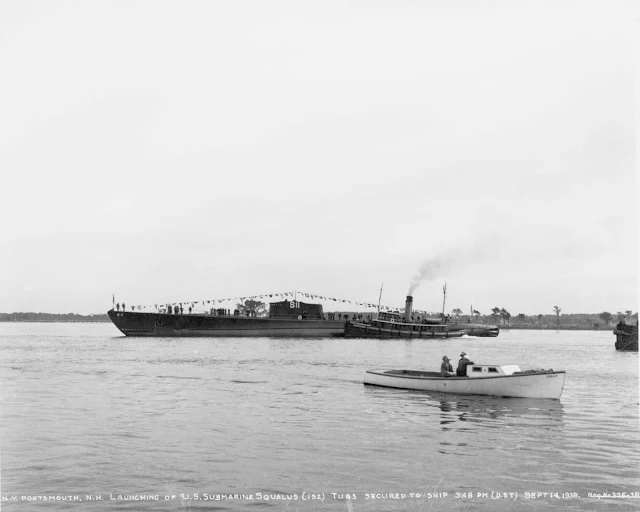 |
| Launching of submarine Squalus (SS-192), tugs secured to ship, Portsmouth, New Hampshire, September 14, 1938. (Naval History and Heritage Command UA 58.04.01) |
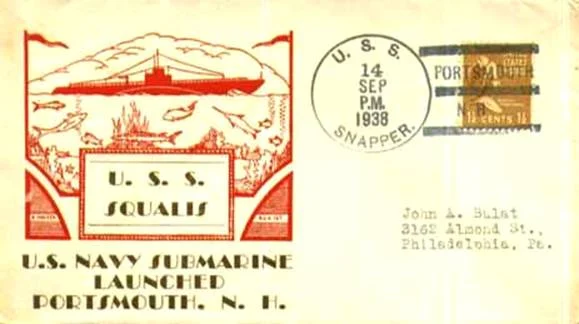 |
| Commemorative postal cover on the occasion of the launching of the Squalus (SS-192), 14 September 1938. |
 |
| Commemorative postal cover on the occasion of the launching of the Squalus (SS-192), 14 September 1938. |
 |
| Squalus (SS-192), fitting out, at Portsmouth Navy Yard, Kittery, Maine, 5 October 1938. (Naval History and Heritage Command NH 79463) |
 |
| Squalus (SS-192), fitting out, at Portsmouth Navy Yard, Kittery, Maine, 7 January 1939. (Naval History and Heritage Command 19-N-109860) |
 |
| Commemorative postal cover on the occasion of the commissioning of the Squalus (SS-192), 1 March 1939. |
 |
| Commemorative postal cover on the occasion of the commissioning of the Squalus (SS-192), 1 March 1939. |
 |
| Squalus (SS-192) Commanding Officer, Lieutenant Oliver F. Naquin. Squalus's Christmas tree was green when she dived. |
 |
| Airplane view of the salvage tug Falcon (ASR-2) on its way to rescue the crew of the sunken Squalus (SS-192). |
 |
| Salvage tug Falcon (ASR-2) to the rescue of crew of the sunken sub Squalus (SS-192). |
 |
| Rescue chamber on the salvage tug Falcon (ASR-2) to be used to rescue crew from sunken Squalus (SS-192). |
 |
| Rescue chamber on the salvage tug Falcon (ASR-2) to be used to rescue crew from sunken Squalus (SS-192). A diver descends from the Falcon. (Boston Public Library 08_06_023271) |
 |
| Stern view of the Falcon (ASR-2) with the McCann Rescue chamber Squalus (SS-192). (Boston Public Library 08_06_023271) |
 |
| Squalus rescue operations, May 1939. McCann Rescue Chamber in the water alongside Falcon. (Naval History and Heritage Command NH 97292) |
 |
| McCann Rescue Chamber. Cutaway drawing of the device used to rescue 33 crewmen from the sunken submarine Squalus in May 1939. (Naval History and Heritage Command NH 97291) |
 |
| Percolating water rises from the salvage pontoons during salvage operations on the sunken submarine, off the New Hampshire coast in the Summer of 1939. (US Navy) |
 |
| Raising the sub Squalus (SS-192) after accident. (Boston Public Library 08_06_023265) |
 |
| The Squalus (SS-192) and her pontoon make way to Portsmouth Navy Yard, Kittery, Maine on 12 August 1939. |
 |
| Newsmen covering the sinking from the newsroom of the Portsmouth Navy Yard, Portsmouth, New Hampshire, on 23-24 May 1939. (Naval History and Heritage Command NH 57506) |
 |
| An unsigned version of the same photo. |
 |
| The salvage pontoons proceed the sunken submarine to drydock. |
 |
| Squalus at Berth 6 for pumping out, Portsmouth Naval Shipyard. The front of the conning tower shows damage caused by lifting pontoons. |
 |
| Another view of the same scene as in the previous photo. |
 |
| Squalus (SS-192) safe in dry dock at Portsmouth Navy Yard, 15 September 1939. |
 |
| Squalus in dry dock after pumping out. The sub has been positioned and the water is being pumped out of the dock. |
 |
| Squalus (SS-192) damaged conning tower and pontoons, 15 September 1939. |
 |
| Damage to conning tower by lifting pontoons. Sub is still being pumped out. |
 |
| Squalus (SS-192) crew and salvage workers pumping out last of the water in Portsmouth Navy Yard after the sub was rinsed. |
 |
| After 113 days of salvage work, the sub Squalus (SS-192) is moored at Pier 6 at the Portsmouth Navy Yard on 15 September 1939. |
 |
| Squalus (SS-192) at the Portsmouth Navy Yard. |
 |
| Untangling the ropes around the conning tower of the Squalus (SS-192) at Portsmouth Navy Yard, 15 September 1939. |
 |
| Squalus (SS-192) in Portsmouth Navy Yard showing pontoons keeping her afloat, 15 September 1939. |
 |
| Night falls on the Squalus (SS-192) at Portsmouth Navy Yard, 15 September 1939. |
 |
| Squalus (SS-192) completely afloat at Portsmouth Navy Yard, 15 September 1939. |
 |
| Squalus (SS-192) conning tower dismantled at Portsmouth Navy Yard to get at bodies of the crew, 15 September 1939. |
 |
| Squalus (SS-192) tilted at awkward angle at Portsmouth Navy Yard, 15 September 1939. |
 |
| Squalus (SS-192) tilted at awkward angle at Portsmouth Navy Yard, 15 September 1939. |
 |
| Lost in thought on deck of the Squalus (SS-192) at Portsmouth Navy Yard, 15 September 1939. |
 |
| Forward torpedo room of the Squalus (SS-192) after raising 15 September 1939. |
 |
| Squalus Forward Torpedo Room condition post salvage. View is looking forward. Photo taken 15 September 1939. |
 |
| Officers Wardroom, USS Squalus, 15 September 1939. View is looking aft and to port. |
 |
| Squalus control room looking aft. Better view of temporary ductwork for drying and ventilating the boat. Photo taken 15 September 1939. |
 |
| Squalus control room looking aft port side. Stern planes control wheel shown. |
 |
| Patch cut out of hull for salvage work. Duct work can be seen leading into the boat to vent gases or dry the interior. |
 |
| USS Squalus salvaged in drydock, 1939 or 1940. |
 |
| Squalus in dry dock post salvage. |
 |
| Squalus in dry dock, post salvage, 16 September 1939. Note lifting chain draped over port propeller shaft just forward of the screw. Salvage pontoons flank the stern. |
 |
| Salvaging of the Squalus (SS-192) at dockside. |
 |
| Damage to hull caused by the lifting chains. |
 |
| Deflections and rupture to hull plating made during lifting process. |
 |
| Damage to bilge keels by lifting chains. |
 |
| Commemorative postal cover on the occasion of the de-commissioning of the Squalus (SS-192), 15 November 1939. |
 |
| Commemorative postal cover on the occasion of the de-commissioning of the Squalus (SS-192), 15 November 1939. |
 |
| One year commemorative postal cover dedicated to the memory of the crew of the Squalus (SS-192) who died at their posts when the boat sank by mechanical failure, 23 May 1939. |
 |
| Admiral Morton C. Mumma, USN was the World War II submarine commanding officer of USS Sailfish, and later a PT boat squadron commander. |
 |
| Commemorative postal cover on the occasion of the re-commissioning of the Sailfish (SS-192), 15 May 1940. |
 |
| Re-introducing the Squalus (SS-192), on the occasion of her re-commissioning on 15 May 1940. |
 |
| Commemorative postal cover on the occasion of the Sailfish's (SS-192) first submergence, 29 June 1940. |
 |
| Commemorative postal cover on the occasion of Squalus (SS-192) shakedown cruise with Lt. Comdr. Morton C. Mumma commanding on 18 November 1940. |
 |
| Sailfish (SS-192) off the Mare Island Navy Yard, Vallejo, California, 13 April 1943. (Naval History and Heritage Command 19-N-43270) |
 |
| Sailfish (SS-192) off the Mare Island Navy Yard, Vallejo, California, 13 April 1943, following an overhaul. (Naval History and Heritage Command NH 97307) |
 |
| Sailfish (SS-192) off the Mare Island Navy Yard, Vallejo, California, 13 April 1943, following an overhaul. (Naval History and Heritage Command NH 97308) |
 |
| Broadside view of the Sailfish (SS-192) off Mare Island on 13 April 1943. |
 |
| Sailfish (SS-192), oil painting, unknown artist, circa 1943/45. |
 |
| Sailfish making her last dive dockside before decommissioning. 27 October 1945, Portsmouth, New Hampshire Shipyard. |
 |
| Sailfish making her last dive dockside before decommissioning. |
 |
| Crowds line the shore 27 October 1945 at Portsmouth Naval Shipyard. The Sailfish (SS-192) was making one last pier side dive prior to decommissioning. |
 |
| The sail of the Sailfish (SS-192) preserved as a memorial to its crew, at the US Navy's Portsmouth Naval Shipyard, Kittery, Maine. |
 |
| This 2010 photo shows the gun access hatch in the after CT bulkhead, located inside the dog house of the Sailfish (SS-192). |
 |
| This photo shows the hatch leading down to the conning tower from the bridge. |
 |
| This is looking down and forward from the bridge. On the lower left the hatch to the conning tower below is visible, and on the right is the open door to the forward gun deck. |
 |
| The after cigarette desk sloping down, with a couple of ready service lockers below the raised aft TDC platform. |


















